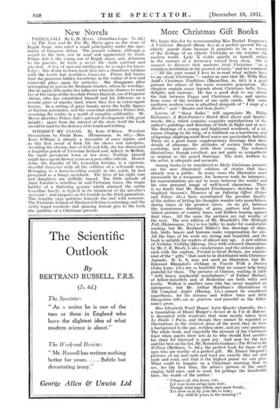More Christmas Gift Books
WE begin this list by recommending Miss Rachel Ferguson's A Victorian 'Bouquet (Bean, Os.) as a perfect present for an
elderly grande dame because it purports to be a record of the feelings of an elderly Victorian as she watches the modern world. Lady X scolds quietly to herself, rather
in the manner of a dormouse roused from sleep. She is
amazed to discover that moderns treat Christmas "as a mistaken institution in the poorest of taste," and her comment
—" All the year round I love to re-read what writers have to say about Christmas "—makes us sure that Mr. Willa Muir Auld's Christmas Traditions (Macmillan, 8s. 6d.) is a good present for others of the more romantic generation. His chapters contain many legends about Christmas bells, trees, delights and customs. He has a good deal to say about the link between Pagan and Christmas rites, and quotes from some of the loveliest of our early carols. But some mediocre modern verse is admitted alongside of "1 singe of a Maiden" and "Beastes and those foules."
Lovers of "those foules " will appreciate Mr. Philip Rickman's A Bird-Painter's Sketch Book (Eyre and Spottis- woode, 30s.), which contains exquisite reproductions of the author's paintings and drawings of birds in flight and at rest. The drawings of a young and frightened woodcock, of a tit- mouse clinging to his twig, of a bullfinch on a hawthorne and of lapwings alighting amid flood water are particularly faithful. There are a good many supplementary drawings that show details of plumage, the attitudes of certain birds during courtship, and parents with their young. The coloured illustrations, though excellent, are not quite so sympathetic or original as the pencil drawings. The text, written by the artist, is adequate and accurate.
Among books to be considered as likely Christmas presents are the new illustrated editions of stories that have already won a public. In many cases the illustrator must necessarily be a trespasser, for, however truly he interprets, his representations are apt to come between the reader and his own personal image of well-loved characters. There is no doubt that Mr. Barnett Freedmann's sketches in Mr. Siegfried Sassoon's Memoirs of an Infantry Officer (Faber and Faber, 21s.) have accentuated the peculiar faculty of the author of letting his thoughts wander into peacefulness during times of the greatest stress. So we get, between the monotonous drawings of guns, puttees and horrors, tinted pictures of country lanes, and ladders leaning against fruit trees. All the same the pictures are not worthy of the text. The new edition of Mr. Masefield's The Midnight Polk (Heinemann, 15s.) is too bulky to make for comfortable reading, but Mr. Rowland Hilder's line drawings of ships, fish, birds, beasts and humans make compensation for size. All the lines of his work are strong and beautiful, and the book is suitable for readers of almost any age. A new edition of Nicholas Nickleby (Harrap, 15s.) with coloured illustrations by Mr. C. E. Brock, is also cumbersome, and the sixteen plates, each with the caption, Printed in Great Britain, are reminis- cent of the " gifts " that used to be distributed with Christmas Annuals. R. L. S. may not need an illustrator, - but Mr. Edmund Blampied's etchings in Travels With a Donkey (John Lane, 15s.) are so beautiful that we cannot help being grateful for them. The pictures of Clarisse, waiting at table
• with heavy implacable nonchalance," of Father Michael, of fellow-travellers and of Modestine are both witty and lovely. Walton is another man who has never required an interpreter, but Mr. Arthur Rackham's illustrations in The Compleat Angler (Harrap, 15s.) cannot be considered superfluous, for his streams and willow trees and little Hampshire hills are as gracious and peaceful as the fisher- man's prose.
Miss Elizabeth Ward Hugus' Latin Quarter (Jarrolds, 18s.), a translation of Henri Murger's Scenes de la Vie de Boheme, is decorated with woodcuts that were mostly taken from Le Diable a Paris, and though they cannot be regarded as illustrations in the strictest sense of the word, they do form a background to the gay, reckless story, and are very amusing. The whole book, and especially the account of the Christmas feast when guests drew lots as to who should first sacrifice his chair for firewood is pure joy. And now for the last and the best on the list, Mr. Kenneth Graham's The Wind in the Willows (Methuen, 75. 6d.), the perfect book for those of all ages who are worthy of a perfect gift. Mr. Ernest Shepard 's pictures of rat and mole and toad are exactly like rat and mole and toad, and that is the highest praise we can give. What could be happier on a Christmas morning than to see, for the first time, the artist's picture of the carol- singing field mice, and to read, for perhaps the hundredth time, the words of the author : "Villagers all, this frosty tide, - Let your doors swing open wide, Though wind may fellow, and snow beside,
Yet draw us in by your fire to bide ; Joy shall be yours in the morning !"


































 Previous page
Previous page